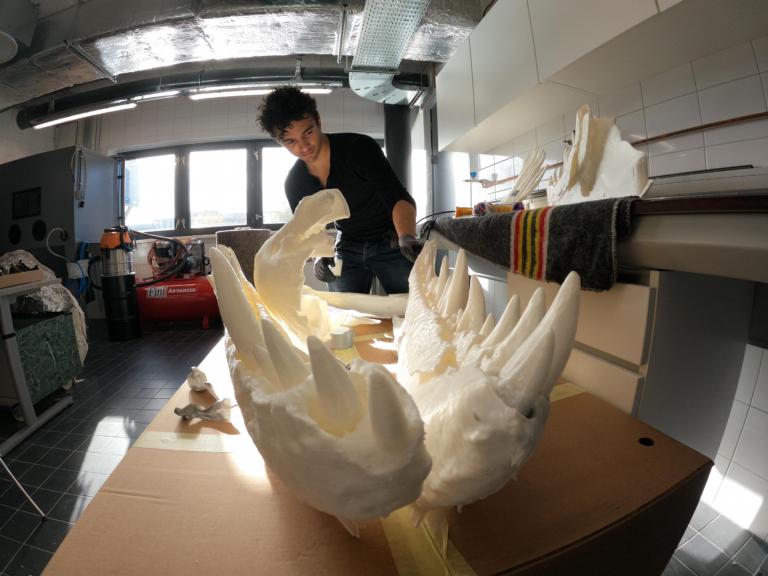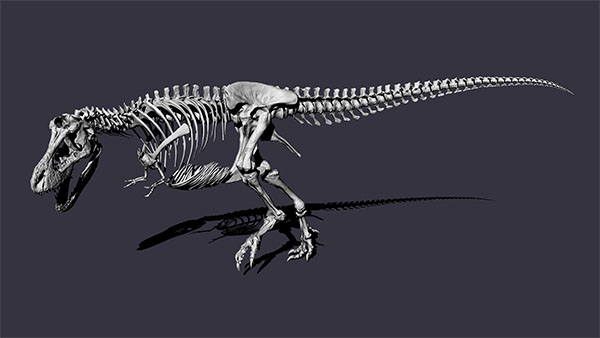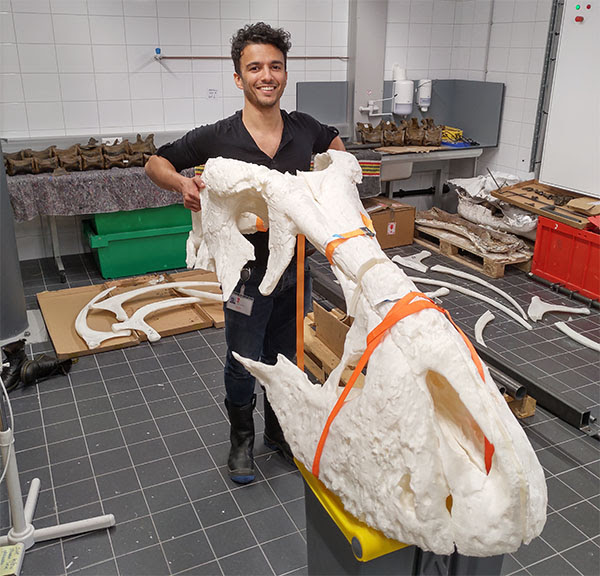
The T. rex skeleton nicknamed ‘Trix’, the well-known Tyrannosaurus rex at Naturalis, is going on a new journey. A reconstruction printed by Naturalis will soon be flying to the Dinosaur Museum in Nagasaki, Japan – and will be demonstrating the importance of scientific research there, too. But first, this unique 3D print of Trix will be publicly assembled in the Naturalis entrance hall in November and December.
Special collaborationto produce exceptional 3D Trix
Trix is regarded as one of the top items at Naturalis – the skeleton of this adult Tyrannosaurus rex is in an unusually good state and very complete. “Because the fossil was preserved in a thick layer of sand, the bones have not been distorted, so we have a perfectly fitting skeleton, which can be seen especially well in the tail vertebrae,” says Anne Schulp, Professor of Vertebrate Palaeontology and dinosaur expert at Naturalis. This is an exclusive skeleton from which no casts or copies have been made so far, but now that’s changing. Naturalis has concluded an agreement with Nagasaki, one of the cities twinned with Leiden, to produce a copy of Trix for the Japanese Dinosaur Museum. This special reconstruction was completed over a year ago: the full skeleton has been printed and colored in 3D.
“The real Trix will of course be staying with us here in Leiden, so don’t worry,” says 3D modeler and anatomist Pasha van Bijlert of Naturalis. He is the one who produced the digital reconstruction of T. rex Trix that rolled out of the Naturalis 3D printers, life-sized, last year. To realize this project, Naturalis has been working together with the Leiden-based instrument makers School en Builder 3D Printers. “We’ve used innovative techniques for this, and so the skeleton looks highly realistic,” explains Van Bijlert.
A life-sizedcopy
The 3D copy of Trix and the original skeleton show some striking differences. For one thing, the 3D Trix has a different posture: the museum in Nagasaki wanted a T. rex that’s striding forwards to attack. The head of the original Trix is close to the ground, while the new 3D Trix stands more upright. This clearly reveals how imposing the skeleton actually is. “One of the reasons the head of our real Trix is so close to the ground is because we wanted to show its wonderful skull. Moreover, the skull is very heavy and valuable, so it’s not something you want to position five meters above the ground,” says Van Bijlert. As a result, visitors to Naturalis stand literally eye to eye with the 66 million-year-old predator.
In contrast, having the 3D Trix stand more upright shows how imposing the skeleton actually is. Moreover, in this reconstruction the knees are fairly close together, which is intentional. “All over the world, the T. rex is often displayed with legs set very wide, which is actually not quite correct if you look at fossilized dinosaur footprints,” explains Van Bijlert. What’s more, the spinal column of the 3D Trix is true to life. Van Bijlert continues: “The real Trix is mounted so that each bone can be removed individually from the frame for research. This means that the vertebrae of the back, neck and tail are further apart than when the animal was alive. In the new reconstruction, I’ve been able to change this because the bones can all stay in place.”

From 3D scanto mounted skeleton
But how do you actually build this kind of 3D reconstruction of a T. rex skeleton? “It all starts with scanning the real bones of Trix. Depending how you count, the skeleton comprises around 320 different bones, and these were scanned one by one,” recounts Van Bijlert. Part of the skeleton had already been scanned between 2014 and 2016 by 3D specialist Valentin Vanhecke. The Naturalis team then scanned the remaining sections. No easy task, says Van Bijlert: “It was really hard work lifting out the lower jaw – we needed three people for that.” After scanning, the bones were positioned digitally and in an anatomically correct way, which also took a lot of time.
Another special thing about the 3D Trix is the “Trixification” of the tail. During assembly, the tail bones of the real Trix were augmented with casts from another T. rex, the recently auctioned Stan, which are in less of a good state. So now Van Bijlert has replaced these casts with modified versions of the original tail bones from Trix: “This means that the tail consists completely of material based on Trix itself, and the whole thing looks lifelike.” A similar reconstruction process has been applied to a number of Trix’s abdominal ribs (gastralia) and jaw. What’s more, some of the bones have been digitally restored.
Then, bones were then sent to the 3D printer and printed using PLA (polylactic acid) bioplastic. This polymer derived from lactic acid is a strong and durable material, but it can, if required, biologically degrade under very ideal circumstances.

The last step was to color the bones and then thread them one by one onto a previously designed frame of rods. This is a major advantage of the digital process, because when mounting a real skeleton, you have to build the frame around the bones to prevent damage. “All the original bones need to remain available for scientific research, and so a separate, individually forged frame was made for each bone. This allows the bones that the researchers want to work on to simply be lifted out,” explains Schulp. This time-consuming process wasn’t needed for the printed reconstruction of Trix: thanks to a 3D technique, it was possible to model the frame beforehand. “I’m able to snip digital holes out of the prints, so that we can later thread them onto the frame,” says Van Bijlert. Moreover, an innovative technique – a sort of modelled hood – was used to enable difficult corner points to fit together seamlessly.
Test set-up for 3D Trixin Naturalis
Before embarking on its journey to Japan, the 3D Trix will first be set up in the Naturalis entrance hall between 19 November and 16 December. “In full view of the public, we’ll be trying out the ‘construction kit’. We want to do a lot of testing and practicing with the assembly process to make sure it goes as smoothly as possible,” explains Van Bijlert. If everything goes according to plan, the unique 3D copy will be shipped to Japan in March.
The entire process can be watched in the museum by visitors to Naturalis on weekdays. You can also come and say hello to the copy of Trix during the Christmas holidays and in January. During this period, the event program will focus on the various aspects involved in copying Trix and transporting it to Japan.
Moreinformation
Van Bijlert had previously constructed Trix’s tail muscles for a study of the animal’s walking/running-speed. This study, supervised by Dr Knoek van Soest and Prof. Anne Schulp, is soon to be published.
- Text: Ela Sari, Naturalis
- Lead photo: 3D modeler and anatomist Pasha van Bijlert with a section of the 3D print of Trix (Source: Naturalis)
- For further information on the 3D T. rex also see the Naturalis video: Spotlight: 3D T. rex
- The missing bones and bone fragments of our Triceratops skeleton have also been made with the help of 3D printers.